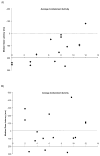Action production influences 12-month-old infants' attention to others' actions
- PMID: 22251290
- PMCID: PMC3261504
- DOI: 10.1111/j.1467-7687.2011.01095.x
Action production influences 12-month-old infants' attention to others' actions
Abstract
Recent work implicates a link between action control systems and action understanding. In this study, we investigated the role of the motor system in the development of visual anticipation of others' actions. Twelve-month-olds engaged in behavioral and observation tasks. Containment activity, infants' spontaneous engagement in producing containment actions; and gaze latency, how quickly they shifted gaze to the goal object of another's containment actions, were measured. Findings revealed a positive relationship: infants who received the behavior task first evidenced a strong correlation between their own actions and their subsequent gaze latency of another's actions. Learning over the course of trials was not evident. These findings demonstrate a direct influence of the motor system on online visual attention to others' actions early in development.
© 2011 Blackwell Publishing Ltd.
Figures



Similar articles
-
Action experience alters 3-month-old infants' perception of others' actions.Cognition. 2005 May;96(1):B1-11. doi: 10.1016/j.cognition.2004.07.004. Cognition. 2005. PMID: 15833301 Free PMC article. Clinical Trial.
-
Action type and goal type modulate goal-directed gaze shifts in 14-month-old infants.Dev Psychol. 2009 Jul;45(4):1190-4. doi: 10.1037/a0015667. Dev Psychol. 2009. PMID: 19586188
-
The developmental origins of naïve psychology in infancy.Adv Child Dev Behav. 2009;37:55-104. doi: 10.1016/s0065-2407(09)03702-1. Adv Child Dev Behav. 2009. PMID: 19673160 Review.
-
Visual experience influences 12-month-old infants' perception of goal-directed actions of others.Dev Psychol. 2011 Jul;47(4):1042-9. doi: 10.1037/a0023765. Dev Psychol. 2011. PMID: 21604864
-
Mirroring and the development of action understanding.Philos Trans R Soc Lond B Biol Sci. 2014 Apr 28;369(1644):20130181. doi: 10.1098/rstb.2013.0181. Print 2014. Philos Trans R Soc Lond B Biol Sci. 2014. PMID: 24778377 Free PMC article. Review.
Cited by
-
Actions Seen through Babies' Eyes: A Dissociation between Looking Time and Predictive Gaze.Front Psychol. 2012 Sep 27;3:370. doi: 10.3389/fpsyg.2012.00370. eCollection 2012. Front Psychol. 2012. PMID: 23060838 Free PMC article.
-
Infants' expectations about gestures and actions in third-party interactions.Front Psychol. 2014 Apr 22;5:321. doi: 10.3389/fpsyg.2014.00321. eCollection 2014. Front Psychol. 2014. PMID: 24795674 Free PMC article.
-
Relations between infants' emerging reach-grasp competence and event-related desynchronization in EEG.Dev Sci. 2016 Jan;19(1):50-62. doi: 10.1111/desc.12295. Epub 2015 Mar 5. Dev Sci. 2016. PMID: 25754667 Free PMC article.
-
Infant and adult visual attention during an imitation demonstration.Dev Psychobiol. 2014 May;56(4):770-82. doi: 10.1002/dev.21147. Epub 2013 Sep 4. Dev Psychobiol. 2014. PMID: 24037972 Free PMC article. Clinical Trial.
-
First-person action experience reveals sensitivity to action efficiency in prereaching infants.Proc Natl Acad Sci U S A. 2013 Nov 12;110(46):18728-33. doi: 10.1073/pnas.1312322110. Epub 2013 Oct 28. Proc Natl Acad Sci U S A. 2013. PMID: 24167247 Free PMC article.
References
-
- Beilock SL, Carr TH. On the fragility of skilled performance: What governs choking under pressure? Journal of Experimental Psychology: General. 2001;130:701–725. - PubMed
-
- Canfield RL, Smith EG, Bresznyak MP, Snow MP. Informational processing through the first year of life: A longitudinal study using the visual expectation paradigm. Monographs of the Society for Research in Child Development. 1997:62. - PubMed
-
- Chartrand TL, Bargh JA. The chameleon effect: The perception-behavior link and social interaction. Journal of Personality and Social Psychology. 1999;76:893–910. - PubMed
-
- Csibra G. Action mirroring and action interpretation: An alternative account. In: Haggard P, Rosetti Y, Kawato M, editors. Sensorimotor Foundations of Higher Cognition. Attention and Performance XXII. Oxford: Oxford University Press; 2007. pp. 435–459.
Publication types
MeSH terms
Grants and funding
LinkOut - more resources
Full Text Sources
Medical

